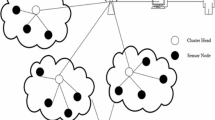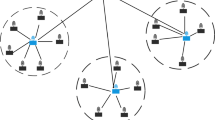Abstract
Due to the limited energy of sensor nodes in wireless sensor networks (WSNs), it is crucial to design an energy-efficient routing protocol for WSNs. However, most current routing protocols cannot balance the energy consumption of nodes well, which leads to the hot spot problem and shortens the network lifetime. This paper proposes an uneven annulus sector grid-based energy-efficient multi-hop routing protocol (UASGRP). The proposed protocol employs an uneven annulus sector grid clustering approach that takes the base station (BS) as the center and divides the network area into annulus sector grids with unequal sizes to balance the energy consumption of nodes. Cluster head (CH) nodes and communication management (CM) nodes are combined to establish routes to transmit data, which lightens the load of CHs. In addition, a multi-hop relay transmission mechanism is used to support the scalability of the network. A nearest interlayer routing algorithm is designed to construct multi-hop transmission routes. Theoretical analysis proves that this algorithm can effectively reduce the energy consumption of relay transmission. Simulation results show that compared with other grid-based clustering schemes, UASGRP can better balance the energy consumption of the network and has greater scalability for various sizes of networks.















Similar content being viewed by others
References
Gupta BB, Quamara M (2020) An overview of Internet of Things (IoT): Architectural aspects, challenges, and protocols[J]. Concurrency and Computation: Pract Exp 32(21):e4946. https://doi.org/10.1002/cpe.4946
Sejdiu B, Ismaili F, Ahmedi L (2020) Integration of Semantics Into Sensor Data for the IoT: A Systematic Literature Review[J]. Int J Semant Web Inf Syst (IJSWIS) 16(4):1–25. https://doi.org/10.4018/IJSWIS.2020100101
Arora VK, Sharma V (2021) A novel energy-efficient balanced multi-hop routing scheme (EBMRS) for wireless sensor networks. Peer-to-Peer Netw Appl 14:807–820. https://doi.org/10.1007/s12083-020-01039-5
Djedouboum AC, Abba Ari AA, Gueroui AM, Mohamadou A, Aliouat Z (2018) Big Data Collection in Large-Scale Wireless Sensor Networks. Sensors (Basel) 18(12):4474. https://doi.org/10.3390/s18124474.PMID:30567331;PMCID:PMC6308481
Rashid B, Rehmani MH (2016) Applications of wireless sensor networks for urban areas: A survey. J Netw Comput Appl 60:192–219. https://doi.org/10.1016/j.jnca.2015.09.008
Zhu B, Bedeer E, Nguyen HH, Barton R, Henry J (2021) Improved Soft-k-Means Clustering Algorithm for Balancing Energy Consumption in Wireless Sensor Networks. In IEEE Internet Things J 8(6):4868–4881. https://doi.org/10.1109/JIOT.2020.3031272
Amodu OA, Raja Mahmood RA (2018) Impact of the energy-based and location-based LEACH secondary cluster aggregation on WSN lifetime. Wireless Netw 24, 1379–1402. https://doi.org/10.1007/s11276-016-1414-9
Toor AS, Jain AK (2016) A survey of routing protocols in Wireless Sensor Networks: Hierarchical routing. 2016 International Conference on Recent Advances and Innovations in Engineering (ICRAIE), Jaipur, pp.1–6. https://doi.org/10.1109/ICRAIE.2016.7939555
Barati H, Movaghar A, Rahmani AM (2015) EACHP: Energy Aware Clustering Hierarchy Protocol for Large Scale Wireless Sensor Networks. Wireless Pers Commun 85:765–789. https://doi.org/10.1007/s11277-015-2807-2
Behera TM, Mohapatra SK, Samal UC, Khan MS, Daneshmand M, Gandomi AH (2020) I-SEP: An Improved Routing Protocol for Heterogeneous WSN for IoT-Based Environmental Monitoring. IEEE Internet Things J 7(1):710–717. https://doi.org/10.1109/JIOT.2019.2940988
Wang J, De Dieu IJ, Jose ADLD, Lee S, Lee YK (2010) Prolonging the lifetime of wireless sensor networks via hotspot analysis. In Proceedings -2010 10th Annual International Symposium on Applications and the Internet, SAINT 2010 (pp.383–386). [5598035] (Proceedings-2010 10th Annual International Symposium on Applications and the Internet, SAINT 2010). https://doi.org/10.1109/SAINT.2010.31
Pant M, Dey B, Nandi S (2015) A Multihop Routing Protocol for Wireless Sensor Network based on Grid Clustering. Applications and Innovations in Mobile Computing (AIMoC) 2015:137–140. https://doi.org/10.1109/AIMOC.2015.7083842
Padmanaban Y, Muthukumarasamy M (2020) Scalable Grid-Based Data Gathering Algorithm for Environmental Monitoring Wireless Sensor Networks. IEEE Access 8:79357–79367. https://doi.org/10.1109/ACCESS.2020.2990999
Sabor Nabil et al (2016) An Unequal Multi-hop Balanced Immune Clustering protocol for wireless sensor networks. Appl Soft Comput 43:372–389. https://doi.org/10.1016/j.asoc.2016.02.016
Heinzelman WR, Chandrakasan A, Balakrishnan H (2000) Energy-efficient communication protocol for wireless microsensor networks. Proceedings of the 33rd Annual Hawaii International Conference on System Sciences 2:10. https://doi.org/10.1109/HICSS.2000.926982
Heinzelman WB, Chandrakasan AP, Balakrishnan H (2002) An application-specific protocol architecture for wireless microsensor networks. IEEE Trans Wireless Commun 1(4):660–670. https://doi.org/10.1109/TWC.2002.804190
Mahboub A, Arioua M (2017) Energy-efficient hybrid k-means algorithm for clustered wireless sensor networks[J]. Int J Electr Comput Eng 7(4):2054. https://doi.org/10.11591/ijece.v7i4.pp2054-2060
Brezinski K, Guevarra M, Ferens K (2020) Population based equilibrium in hybrid sa/pso for combinatorial optimization: hybrid sa/pso for combinatorial optimization[J]. Int J Soft Sci Comput Intell (IJSSCI) 12(2):74–86. https://doi.org/10.4018/IJSSCI.2020040105
Cao N et al (2018) Evaluation Models for the Nearest Closer Routing Protocol in Wireless Sensor Networks. IEEE Access 6:77043–77054. https://doi.org/10.1109/ACCESS.2018.2825441
Khekare G, Verma P, Dhanre U et al (2020) The optimal path finding algorithm based on reinforcement learning[J]. Int J Soft Sci Comput Intell (IJSSCI) 12(4):1–18. https://doi.org/10.4018/IJSSCI.2020100101
Manasrah AM, Gupta BB (2019) An optimized service broker routing policy based on differential evolution algorithm in fog/cloud environment[J]. Clust Comput 22(1):1639–1653. https://doi.org/10.1007/s10586-017-1559-z
Ruan D, Huang J (2019) A PSO-Based Uneven Dynamic Clustering Multi-Hop Routing Protocol for Wireless Sensor Networks [J]. Sensors 19(9):1835. SCI, EI: Accession number:20192607123031. https://doi.org/10.3390/s19081835
Shahbaz AN, Barati H, Barati A (2021) Multipath routing through the firefly algorithm and fuzzy logic in wireless sensor networks. Peer-to-Peer Netw Appl 14:541–558. https://doi.org/10.1007/s12083-020-01004-2
Al-Karaki JN, Ul-Mustafa R, Kamal AE (2004) Data aggregation in wireless sensor networks - exact and approximate algorithms. Workshop on High Performance Switching and Routing HPSR 2004:241–245. https://doi.org/10.1109/HPSR.2004.1303478
Jannu S, Jana PK (2016) A grid based clustering and routing algorithm for solving hot spot problem in wireless sensor networks. Wireless Netw 22:1901–1916. https://doi.org/10.1007/s11276-015-1077-y
Sajwan M, Gosain D, Sharma AK (2019) CAMP: cluster aided multi-path routing protocol for wireless sensor networks. Wireless Netw 25:2603–2620. https://doi.org/10.1007/s11276-018-1689-0
Soro S, Heinzelman WB (2005) Prolonging the lifetime of wireless sensor networks via unequal clustering. 19th IEEE International Parallel and Distributed Processing Symposium, Denver, CO 8. https://doi.org/10.1109/IPDPS.2005.365
Chen G, Li C, Ye M et al (2009) An unequal cluster-based routing protocol in wireless sensor networks. Wireless Netw 15:193–207. https://doi.org/10.1007/s11276-007-0035-8
Xia H, Zhang Rh, Yu J et al (2016) Energy-Efficient Routing Algorithm Based on Unequal Clustering and Connected Graph in Wireless Sensor Networks. Int J Wireless Inf Networks 23:141–150. https://doi.org/10.1007/s10776-016-0304-5
Yuea J, Zhang W, Xiao W, Tang D, Tang J (2012) Energy efficient and balanced cluster-based data aggregation algorithm for wireless sensor networks. Procedia Eng 29:2009–2015. https://doi.org/10.1016/j.proeng.2012.01.253
Huang J, Hong Y, Zhao Z et al (2017) An energy-efficient multi-hop routing protocol based on grid clustering for wireless sensor networks. Cluster Comput 20:3071–3083. https://doi.org/10.1007/s10586-017-0993-2
Huang J, Ruan D, Meng W (2018) An annulus sector grid-based energy-efficient multi-hop routing protocol for wireless sensor networks [J]. Comput Netw 147(12):38–48. https://doi.org/10.1016/j.comnet.2018.09.024
Acknowledgements
This work is supported in part by the National Science Foundation of China grant number [61472139]; the key project of Shanghai Science and Technology Commission grant number [11511504403].
Author information
Authors and Affiliations
Corresponding author
Additional information
Publisher's Note
Springer Nature remains neutral with regard to jurisdictional claims in published maps and institutional affiliations.
Rights and permissions
About this article
Cite this article
Huang, J., Li, T. & Shi, Z. An uneven annulus sector grid-based energy-efficient multi-hop routing protocol for wireless sensor networks. Peer-to-Peer Netw. Appl. 15, 559–575 (2022). https://doi.org/10.1007/s12083-021-01261-9
Received:
Accepted:
Published:
Issue Date:
DOI: https://doi.org/10.1007/s12083-021-01261-9




